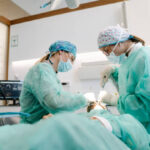e have already talked on other occasions about how important it is to have a beautiful smile. But there are times when lip augmentation or showing perfect white teeth is not enough to have a sweet or beautiful gesture. For this reason, more and more people go through the operating room to have a buccinoplasty, an intervention that seeks to draw those dimples in the smile that achieve “the wrist smile”, which for some is “the perfect smile.
Why do some people have dimples?
Dimples are marks that appear on our cheeks when there is an imperfection or abnormality in the buccinator muscle, which is located on the cheek, just behind the masseter muscle. This muscle is responsible for shaping the face so that our face is more elongated or round, it participates in chewing and is the one that allows us to whistle, suck, blow or play a wind instrument through the pressure it exerts on the cavity of mouth.
Its appearance seems to be a genetic defect in the buccinator muscle that is transmitted from parents to children; that’s why not everyone can boast of them. In fact, dimples are a special trait that only some people have, it is believed that about 20% of the population; They make your face attractive, beautify your smile and soften your features. Precisely for all this, his presence is associated with seduction and eroticism. Hence, in recent years many people have decided to undergo dimple surgery to draw these characteristic and special marks on their face.

What is buccinoplasty?
The buccinoplasty, also known as dimpleplasty , is the surgical intervention by which the surgeon makes dimples in the patient’s face, either in the cheeks themselves, in an area closer to the lips or on the chin. It is a relatively simple and fast operation, since it does not last more than 40-60 minutes, and it is carried out under local anesthesia.
To make the coveted dimples, the doctor makes an incision in the skin from the inside of the cheek, for dimples on the cheeks, or from the lower lip, in the case of dimples on the chin. Through it, it creates a small hole, which can be oval or round, very marked or slightly marked, and which will generate a dimple in the surface of the patient’s skin. As the incision to make the hole is made inside the mouth, no scar is visible, only the dimples, or the dimple, that the patient has requested. The wound is closed with absorbable sutures.
Postoperative care
After the buccinoplasty , the patient will have to follow the recommendations dictated by the surgeon. This will recommend 24 hours of rest and 15 days of special care. The doctor will advise taking analgesics to counteract the pain and discomfort generated with the operation, which can last several days. He may also recommend taking antibiotics to minimize possible risks of infection.
Also, you must be careful not to hit the affected area by the intervention, and eat and chew delicately. Some surgeons apply paper tape, which is breathable and hypoallergenic, to facilitate healing. Until your doctor tells you to, you should wear it. Normally it is 12-15 days, but the doctor will assess the appropriate time for each patient.
Before the operation, the healthcare professional will have recommended the patient to stop smoking to avoid possible risks of infection after the intervention. This prohibition should continue during the postoperative period until the surgeon deems it appropriate.
Finally, the patient must perform a proper oral cleaning to keep the oral cavity clean and germ-free. If the doctor deems it appropriate, you can use liquid mouthwash to facilitate hygiene.
Risks and indications for dimple surgery
Although a priori everyone who wants to show off dimples during their smile or wants to define their face can undergo this intervention, the buccinoplasty, it is the doctor who, after examining the patient, will consider the operation suitable. The main requirement: that there is no oral impediment that makes surgery unfeasible. Among these impediments, the most prominent is infection .
Like any operation worth its salt, it is also not indicated in pregnant or breastfeeding women. Likewise, those people with pathologies such as hypertension, coronary heart disease, diabetes … will have to consult with their doctor about the suitability of the whelk.
Regarding risks, the main one is that surgery, if not carried out by professionals in surgery and medicine with extensive experience in this type of intervention, can cause damage to the lip, and even to the salivary glands. Hence, it is necessary to go only to doctors who specialize in this type of treatment.

Of course, like every operation, there are also other minor risks, such as healing problems, infection, bleeding … Although they are very unlikely, it is important to highlight them, as they are associated with any surgical intervention, so they must be taken into account as well.
In the same way, it is normal for bruises to appear in the area of the cheeks or chin after the operation, as well as for the area to appear slightly swollen. These side effects can last a few days and will go away on their own.
Finally, there is a small percentage risk that dimples will disappear over time. In this case, it will be necessary to repeat the operation to achieve the desired objective.
Remember, despite being a simple, fast and safe intervention, to avoid problems, it should always be carried out by a professional specialized in aesthetic surgery and medicine.






GIPHY App Key not set. Please check settings